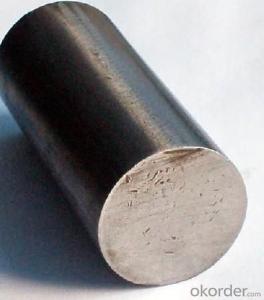Mild Hot Rolled Steel Round Bars for Bults and Nults
- Loading Port:
- Tianjin
- Payment Terms:
- TT or LC
- Min Order Qty:
- 25 m.t.
- Supply Capability:
- 200000 m.t./month
OKorder Service Pledge
OKorder Financial Service
You Might Also Like
Product Description:
OKorder is offering high quality Mild Hot Rolled Steel Round Bars for Bults and Nults at great prices with worldwide shipping. Our supplier is a world-class manufacturer of steel, with our products utilized the world over. OKorder annually supplies products to European, North American and Asian markets. We provide quotations within 24 hours of receiving an inquiry and guarantee competitive prices.
Product Applications:
Mild Hot Rolled Steel Round Bars for Bults and Nultsare ideal for structural applications and are widely used in the construction of buildings and bridges, and the manufacturing, petrochemical, and transportation industries.
1. Steel round bar products is used in construction and a large number of architectural and engineering structures. And it can be used in production of handrail, windows, machinery, telecom and curtain wall.
2. It can be used in the fields like metal mines, cement plants, water coal slurry, power stations and chemical industry.
3. Besides, we can supply some especial material steel round bar that can be used for main shaft of steamer, hummer shank, with big section and supper force.
4. Recommended watchcase factory, screw factory and other cold stamping products industry use.
Product Advantages:
OKorder's Steel I-Beams are durable, strong, and resist corrosion.
1. The steel in which the main interstitial alloying constituent is carbon in the range of 0.12–2.0%.
2. As the carbon percentage content rises, steel has the ability to become harder and stronger through heat treating; however it becomes less ductile.
3. Regardless of the heat treatment, higher carbon content reduces weld ability. In carbon steels, the higher carbon content lowers the melting point.
4. Quality should be in conformity with the specification of the manufacturer. Quantity and packing conditions should be in conformity with the term in the contract.
Main Product Features:
· Premium quality
· Prompt delivery & seaworthy packing (30 days after receiving deposit)
· Corrosion resistance
· Can be recycled and reused
· Mill test certification
· Professional Service
· Competitive pricing
Specifications of Mild Hot Rolled Steel Round Bars for Bults and Nults
1. Grade: Q235, A36, SS400, S235JR
2. Feature: Unbreakable, grinding resistant and high impact value
3. Diameter: 8mm-150mm
4. Performance: Mainly for civil construction
5. Characteristics: Even hardness, no deformation, no breaking, no mal-roundness
6. Technique: Hot rolled
7. Mass: Mass (kg/m) = Diameter (mm) × Diameter (mm) × 0.00617
Packaging & Delivery of Mild Hot Rolled Steel Round Bars for Bults and Nults
Packaging Detail: All goods are packed in bundle with steel strips and shipped by break bulk vessel or container (depend on target market and different ports)
Delivery Detail: 45 days
Trade terms: FOB, CFR, CIF
MOQ: 25 tons per specification; we can negotiate the quantity if the specification is normal or we have stock of one specification.
Weight: The price invoicing on theoretical weight basis or actual weight basis depends on customer’s request.
Shipment: The shipment of bulk break or container is depends on customer’s request and the situation of the port of destination.
Documents given: Full set of original clean on board bill of lading; Original signed commercial invoice; Original packing list; Policy of insurance; Certificate of origin and what the target market needs.


Production Flow of Mild Hot Rolled Steel Round Bars for Bults and Nults
Material prepare (billet) — heat up — rough rolling — precision rolling — cooling — packing — storage and transportation
FAQ:
Q1: The products are invoicing on theoritical weight or on actual weight?
A1: We can do it in both manners, according to the customers' request.
Q2: What is the normal tolerance of Hot Rolled Mild Steel Angle Beams for Structures and for Buildings?
A2: Normally 3%-5%, but we can also produce the goods according to the customers' requests.
Q3: How soon can we receive the product after purchase?
A3: Within three days of placing an order, we will begin production. The specific shipping date is dependent upon international and government factors, but is typically 7 to 10 workdays.
- Q:What are the different shapes available in steel round bars?
- Steel round bars are available in a variety of shapes, each designed to meet specific needs and applications. Some of the common shapes of steel round bars include: 1. Round: This is the most common and basic shape of steel round bars. It has a circular cross-section and is widely used in various industries for applications such as construction, manufacturing, and engineering. 2. Square: Square steel round bars have a square cross-section, making them suitable for applications that require stability and structural strength. They are commonly used in the construction of frames, supports, and braces. 3. Hexagonal: Hexagonal steel round bars have six flat sides and are often used in applications that require better grip and torque resistance, such as in machinery and tools. The hexagonal shape allows for a more secure connection and prevents slippage. 4. Flat: Flat steel round bars have a rectangular cross-section with two flat sides. They are commonly used for structural applications, such as in building frames and supports, as well as in the manufacturing of machinery and equipment. 5. Half-round: Half-round steel round bars have a semi-circular cross-section with one flat side. They are often used as decorative elements in architecture and furniture, as well as in the construction of railings and handles. 6. Oval: Oval steel round bars have an elongated oval shape, providing a unique aesthetic appeal. They are commonly used in decorative applications, such as in the design of furniture, railings, and artistic structures. Overall, the availability of different shapes in steel round bars allows for versatility in various industries, enabling engineers, manufacturers, and designers to choose the most suitable shape based on their specific requirements.
- Q:Can steel round bars be heat treated to enhance their properties?
- Yes, steel round bars can be heat treated to enhance their properties. Heat treatment is a process of heating and cooling the steel in a controlled manner to alter its microstructure, which in turn improves its mechanical properties such as strength, hardness, toughness, and ductility. There are several heat treatment methods that can be applied to steel round bars, depending on the desired outcome. One common method is quenching and tempering. In this process, the steel is heated to a high temperature to form a uniform austenitic structure, and then rapidly cooled by quenching it in a medium such as oil or water. This rapid cooling transforms the austenite into a harder and stronger structure called martensite. However, martensite can be brittle, so the steel is then tempered by reheating it to a lower temperature, which reduces the brittleness and increases toughness while maintaining the desired hardness. Another heat treatment method is annealing, where the steel is heated to a specific temperature and then slowly cooled to relieve internal stresses and improve ductility. This process can also refine the grain structure of the steel, resulting in improved machinability and formability. In addition, there are other heat treatment methods such as normalizing, stress relieving, and case hardening, each designed to enhance specific properties of the steel round bars. Overall, heat treatment is a versatile and effective technique to enhance the properties of steel round bars, allowing them to meet specific requirements for various applications in industries such as manufacturing, construction, automotive, and aerospace.
- Q:Are steel round bars suitable for decorative purposes?
- Indeed, decorative purposes can be served by steel round bars. Steel, being a versatile and durable material, can be molded and crafted into numerous designs and patterns. The application of steel round bars extends to the creation of decorative elements like railings, furniture, sculptures, and architectural details. The polished and lustrous surface of steel contributes a contemporary and elegant touch to any area. Moreover, the strength and longevity associated with steel make it a pragmatic option for decorative endeavors, as it can endure environmental conditions and preserve its visual appeal throughout time.
- Q:What are the advantages of using spring steel round bars?
- Some advantages of using spring steel round bars include their high tensile strength, excellent resilience, and durability. They are able to withstand heavy loads and provide reliable support in various applications. Additionally, spring steel round bars offer good flexibility and are resistant to bending or breaking, making them ideal for use in springs, tools, machinery, and automotive components.
- Q:What are the common alloying elements used in steel round bars?
- Steel round bars commonly contain alloying elements such as carbon, manganese, silicon, sulfur, and phosphorus. Carbon, the most significant alloying element, is responsible for the steel's strength and hardness. It enhances overall performance, increasing durability and resistance to wear and tear. Manganese, another crucial element, improves hardenability and strength while reducing brittleness and increasing toughness. Silicon is added to enhance the steel's resistance to oxidation, while small amounts of sulfur and phosphorus improve machinability. These alloying elements collaborate to produce steel round bars with specific properties suitable for various applications in industries such as construction, automotive, and manufacturing.
- Q:What are the different types of steel used in manufacturing round bars?
- There are several different types of steel that are commonly used in the manufacturing of round bars. Some of the most common types include: 1. Carbon Steel: This is the most common type of steel used in manufacturing round bars. It is made up primarily of iron and carbon, and is known for its strength and durability. Carbon steel round bars are used in a wide range of applications, including construction, automotive, and machinery. 2. Alloy Steel: Alloy steel is made by adding various elements to carbon steel, such as manganese, nickel, chromium, and molybdenum. These additional elements enhance the strength and hardness of the steel, making it ideal for applications that require high strength and resistance to wear and tear. 3. Stainless Steel: Stainless steel is a type of alloy steel that contains a minimum of 10.5% chromium. This high chromium content gives stainless steel its unique corrosion resistance properties, making it suitable for applications where exposure to moisture or chemicals is a concern. Stainless steel round bars are commonly used in the manufacturing of kitchen utensils, medical equipment, and automotive parts. 4. Tool Steel: Tool steel is a type of alloy steel that is specifically designed to have high hardness, wear resistance, and heat resistance. It is commonly used in the manufacturing of cutting tools, dies, and molds. Tool steel round bars are typically made from high-carbon steel with additional elements like tungsten, vanadium, or cobalt. 5. Bearing Steel: Bearing steel is a type of alloy steel that is specifically designed for use in bearing applications. It is characterized by its high hardness, wear resistance, and fatigue strength. Bearing steel round bars are commonly used in the manufacturing of bearings for various industries, including automotive, aerospace, and industrial machinery. These are just a few examples of the different types of steel used in the manufacturing of round bars. The specific type of steel chosen will depend on the desired properties and requirements of the application.
- Q:Can steel round bars be used in the production of springs?
- Yes, steel round bars can be used in the production of springs. Steel is a common material used in the manufacturing of springs due to its high strength and durability. Steel round bars are often used to create the base material for springs, as they can be easily shaped and formed into the desired spring shape. Additionally, steel round bars can be heat-treated to enhance their mechanical properties, making them suitable for various spring applications. The specific type of steel used will depend on the desired characteristics and requirements of the spring, such as the desired level of flexibility and resistance to deformation. Overall, steel round bars are widely utilized in the production of springs due to their excellent mechanical properties, making them a suitable choice for many spring applications.
- Q:What are the advantages of using magnesium-alloy steel round bars?
- There are several advantages of using magnesium-alloy steel round bars: 1. Lightweight: Magnesium is one of the lightest structural materials available, making magnesium-alloy steel round bars significantly lighter than traditional steel bars. This makes them ideal for applications where weight reduction is crucial, such as aerospace and automotive industries. 2. High strength-to-weight ratio: Despite being lightweight, magnesium-alloy steel round bars have a high strength-to-weight ratio. This means they can withstand high loads and provide excellent structural integrity while still maintaining a low weight. 3. Corrosion resistance: Magnesium-alloy steel round bars have excellent corrosion resistance properties, making them suitable for outdoor and marine applications. They can withstand exposure to saltwater, humidity, and other corrosive environments without significant degradation. 4. High machinability: Magnesium-alloy steel round bars are known for their superior machinability, allowing for easy shaping, cutting, and drilling. This makes them desirable in industries that require precise and complex component manufacturing. 5. Good heat dissipation: Magnesium has excellent thermal conductivity, which means that magnesium-alloy steel round bars can effectively dissipate heat. This makes them suitable for applications where heat management is critical, such as in heat sinks for electronic devices or engine components. 6. Eco-friendly: Magnesium is a highly recyclable material, and using magnesium-alloy steel round bars can contribute to a more sustainable and environmentally friendly manufacturing process. The ability to recycle and reuse magnesium alloys minimizes waste and reduces the overall environmental impact. 7. Cost-effective: While magnesium alloys may have a higher initial cost compared to traditional steel, their lightweight nature can lead to significant cost savings in transportation and installation. Additionally, their corrosion resistance and durability reduce the need for frequent maintenance and replacement, further lowering long-term costs. In conclusion, the advantages of using magnesium-alloy steel round bars include their lightweight nature, high strength-to-weight ratio, corrosion resistance, high machinability, good heat dissipation, eco-friendliness, and cost-effectiveness. These properties make them a desirable choice for various industries, particularly those that prioritize weight reduction, performance, and durability.
- Q:How are steel round bars measured?
- Steel round bars are typically measured by their diameter. The diameter is determined by measuring the distance across the widest point of the bar, usually in millimeters or inches. It is important to note that the diameter measurement is taken at the greatest cross-section of the round bar, which is the distance across the center point. This measurement is crucial for various applications as it helps determine the strength, stability, and load-bearing capacity of the steel round bar.
- Q:Are steel round bars available in custom sizes?
- Indeed, one can find steel round bars in custom sizes. Steel manufacturers and suppliers have the capability to produce round bars according to precise size demands and specifications. It is possible to make requests for custom sizes based on the diameter, length, and overall dimensions of the round bar. Whether it is for a particular project or application, numerous steel manufacturers and suppliers provide the opportunity to tailor the size of round bars to cater to individual requirements.
1. Manufacturer Overview |
|
|---|---|
| Location | |
| Year Established | |
| Annual Output Value | |
| Main Markets | |
| Company Certifications | |
2. Manufacturer Certificates |
|
|---|---|
| a) Certification Name | |
| Range | |
| Reference | |
| Validity Period | |
3. Manufacturer Capability |
|
|---|---|
| a)Trade Capacity | |
| Nearest Port | |
| Export Percentage | |
| No.of Employees in Trade Department | |
| Language Spoken: | |
| b)Factory Information | |
| Factory Size: | |
| No. of Production Lines | |
| Contract Manufacturing | |
| Product Price Range | |
Send your message to us
Mild Hot Rolled Steel Round Bars for Bults and Nults
- Loading Port:
- Tianjin
- Payment Terms:
- TT or LC
- Min Order Qty:
- 25 m.t.
- Supply Capability:
- 200000 m.t./month
OKorder Service Pledge
OKorder Financial Service
Similar products
New products
Hot products
Related keywords































